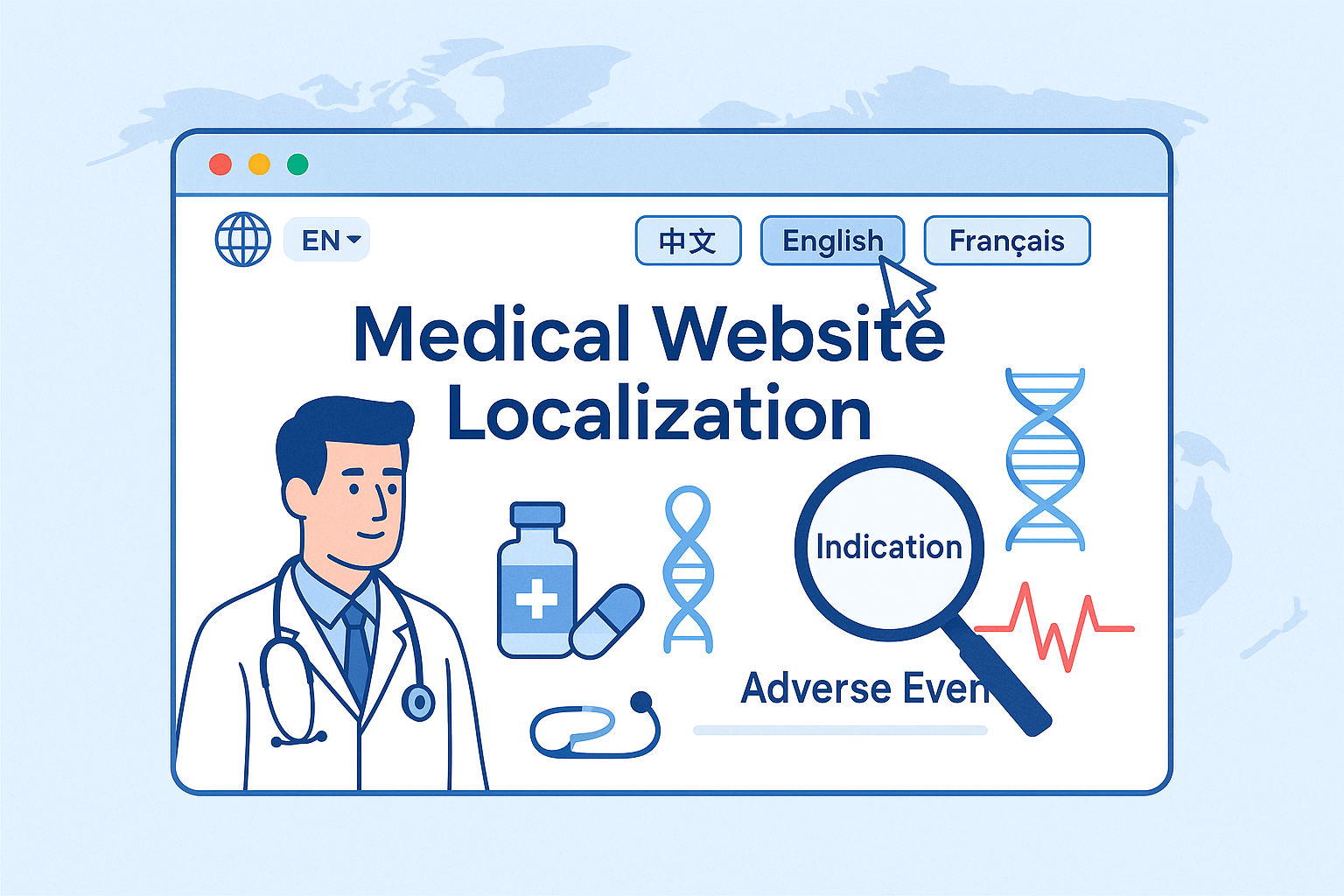As Chinese medical enterprises accelerate their global expansion, multilingual websites have become the “first window” for reaching overseas doctors, patients, and regulators. Yet many companies still equate localization with mere “translation,” overlooking the stringent requirements for terminological accuracy, regulatory compliance, and consistency of expression.
A single mistranslation can alter patient understanding—or trigger compliance risks.
This article focuses on the core of medical localization—terminology management—and explains how to build a dedicated terminology system that ensures professionalism, consistency, and credibility across your digital content.

I. Why Terminology Management Is the Foundation of Localization
Medical translation is not ordinary language conversion. It is a systematic process that involves clinical accuracy, regulatory compliance, and brand trust. The margin for error is extremely low.
The U.S. Food and Drug Administration (FDA), in multiple Warning Letters to medical device companies, has highlighted that non-compliance in labeling and promotional materials is one of the most frequent violations (FDA, Warning Letters Database). Examples include misleading product descriptions, unapproved claims, or missing safety information.
Even a minor mistranslation can have serious consequences:
lTranslating “contraindication” as “forbidden symptom” could mislead patients on therapy eligibility.
lSoftening “adverse event” to “side effect” can downplay risk information, violating FDA disclosure requirements.
lUsing non-standard abbreviations like “Tx” for “treatment” may appear unprofessional in formal contexts.
In the U.S., website content is considered part of a medical device’s labeling/promotional material. Wording must match the Instructions for Use (IFU)—accurate, truthful, and non-misleading.
A real case: an IVD antigen self-test was recalled because labeling and performance claims did not match clinical data (Innova Medical Group Antigen Test, FDA Recall Notice). FDA Warning Letters have also directly cited company websites as evidence. For example, vague wording like “test as soon as possible” without specifying “within 30 minutes” for sample detection windows can be deemed misbranding.
👉Key fact: Medical websites may not be official registration files, but FDA, EMA, and other regulators often classify them as promotional material, requiring the same standard of consistency as product labeling (FDA Guidance: Off-Label Promotion, 2022).
II. Terminology Risks by Content Module
Content Type | High-Risk Terms | Potential Consequences |
Product Features | Indication, Mechanism of Action (MOA) | Ambiguity can lead to off-label promotion |
Safety Information | Contraindications, Warnings, Precautions | Inconsistency with FDA labels = compliance defect |
Patient Guides | Dosage instructions, procedural steps | Poor clarity reduces adherence, increases misuse risk |
Regulatory Claims | FDA cleared/approved, CE marked | Mislabeling may constitute false advertising |
Even inconsistent usage is a risk. For example, mixing “AI-powered” and “artificial intelligence-based” across pages may seem minor but could raise questions from regulators about governance and accuracy.
👉Terminology management should extend beyond registration filings to all external communications—especially corporate websites as digital brand assets.
III. Three Core Steps to Building a Dedicated Medical Terminology Database
Step 1: Extraction & Standardization
Start with authoritative internal sources:
FDA submission documents (510(k), PMA, IND, etc.)
lProduct IFUs (Instructions for Use)
lClinical study reports
lApproved labeling
Extract high-frequency, mission-critical terms and compile bilingual glossaries enriched with metadata:
lDefinition: medical meaning of the term
lContext: applicable content types
lSynonyms/Forbidden Terms: specify alternatives to avoid inconsistency
Example:
Chinese | English | Definition | Context | Forbidden Terms |
适应症 | Indication | Conditions for which the product is approved | Product pages, clinical data | “use case” |
不良事件 | Adverse Event | Negative medical occurrence associated with use | Safety info, patient guides | “side effect” (unless describing minor reactions) |
This stage should be led by medical writers in collaboration with regulatory, clinical, and marketing teams.
Step 2: Review & Compliance Alignment
The draft terminology list must undergo multi-level validation:
lMedical Review: ensure scientific and clinical accuracy
lLinguistic Review: native-language medical translators verify natural, professional usage
lCompliance Review: cross-check against FDA, EMA, and other regulatory standards
Special attention for sensitive terms:
lCure vs. Treatment: avoid “cure” unless fully approved
lSafe and Effective: requires substantial clinical evidence—otherwise use “designed for safety”
lUnits of measure: adapt to local norms (lbs in U.S., kg in EU)
Approved lists should be archived as corporate assets with defined update procedures.
Step 3: Implementation & Tool Integration
Static Excel sheets are not enough. Terminology must be embedded into workflows:
lCAT Tools Integration: import glossaries into Trados, MemoQ, etc., set “forced match” rules to ensure translators use standard terms.
lCMS Integration: deploy plugins that scan for non-standard terms before publishing.
lVersion Control: update regularly with product iterations or regulatory changes; notify all stakeholders.
Conclusion: Terminology as the Silent Ambassador of Medical Localization
In healthcare, every term reflects professionalism, and every word builds trust. Creating a dedicated terminology database is not a one-time translation project—it is a long-term brand infrastructure.
Only with consistency can companies achieve scalable trust. As the saying goes: “You can’t scale trust without consistency.”
Coming Next
Terminological accuracy is only the first step. In our next article, we will explore Cultural Adaptive Translation—How to Ensure Overseas Patients Not Only Understand But Also Trust And Act on Your Content.
Landelion China: Your Medical Localization Partner
Landelion provides multilingual localization services for medical enterprises, supporting global website development and compliance optimization. If your company is planning international expansion—or questioning the effectiveness of current localization—contact us today.




